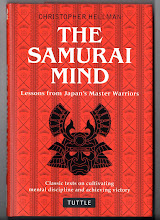 |
| This is section of a painting by Ryohei Yamashita..used for the cover of a novel about (and entitled?) Bokuden |
One of the challenges of studying a discipline in another language is understanding the multiple meanings that pertain to certain expressions. I have often found myself quite able to understand an expression in a particular context, only to fail to realise its wider implications or, indeed, its more general meaning.
My teachers have always taken great pains in their explanations to me and other non-Japanese members of the dojo, but even so, explanations often fail to achieve the resonance that would be felt by a native speaker. This is even more true in the mysterious world of the intangible concepts that form an important part of higher level bujutsu.
An example of this is the term metsuke. This means where you look or what you look at, but it can often be reduced in meaning to a particular kind of looking or gaze, depending largely on the specific circumstances in which it is usually encountered by a student. In kendo, for example, enzan no metsuke is encouraged - abroad gaze that takes in everything... the opposite of tunnel vision.
However, even within that trope, there must be an awareness of what is important or relevant to the confrontation, and what is not. This kind of sight is what enables you to, eventually see through the enemy, to intuit his moves. To what extent this is a function of the conscious mind is a moot point - certainly, enzan no metsuke works on one level by allowing us to see movement that we may not be consciously aware of. On the other hand, a more precise awareness of where such movements begin, of what constitutes this kind of movement, is surely a necessity (or at least a big help) for developing higher level skills.
However, anecdotes are legion of those masters who had developed superlative ability, but were unable or unwilling to analyse the source of this ability, but instead taught only in the broadest of terms. This is what Kano Jigoro experienced when studying jujitsu - his teacher would repeatedly throw him but couldn't explain how he was able to do it.
Another example is the old cat's teacher in Neko no Myojutsu, who could not explain his skills. Similarly Kimura Kyuho, in his Kenjutsu no Fushikihen (The Unknown in Swordsmanship), concludes by saying that the root of this knowledge is unknown and unknowable.
My favorite story, however, is about Tsukuhara Bokuden.
In one 'friendly' duel he fought with wooden swords, he struck his opponent in the head, causing him to go deaf.
His opponent, far from being discouraged, was able to develop his skill to new heights, developing a fearsome concentration through this disability. Some years later, they fought a return match. Bokuden instantly realized his opponent was now of a near equal ability to himself. Putting up his sword as if the contest was at an end, he stepped back. His opponent, assuming the contest was over and that Bokuden had said as much, likewise put up his sword, bowed and turned to exit the field... at which point Bokuden smashed him over the head from behind. This blow caused his hearing to return, and he found he had lost the ability the had developed while he was deaf.
Clearly, his senses, especially those that fall into the intangible category of mukei, had been heightened by his plunge into deafness. Bokuden was quick to realise this, but as other anecdotes show, he was a master of the broader aspects of strategy as well, and was quick to utilise these when appropriate.












